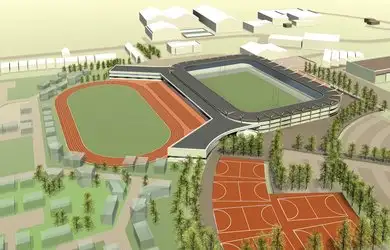Knights unveil their community stadium vision

York City Knights have announced their plans for a 9000 capacity community stadium, based at their current Huntington stadium home.
The Knights believe that the community Stadium scheme will boast world-class sporting facilities that provide a wide range of amenities and services way beyond its core use, accommodating commercial activities which will help to generate extra revenue and give added financial stability for York City FC, York City Athletics Club and York City Knights RLFC and contribute to the wider economy of the city of York.
In a statement released by the club, Knights Chairman John Guildford said: “The stadium site will be for the people of York – a source of pride and community cohesion, not just a home ground for the football and rugby clubs. As a base for all sports clubs in the city, it will allow the clubs community development staff to use the stadium as a place to deliver sports initiatives to a wide range of young people.”
“Plans proposed by York City Knights RLFC are indicative; however these should be used as a starting point for the development of the new community facilities which will include multi-sports facilities such as a Sports Hall and 3G pitches.”
The proposed stadium will incorporate the latest environmental features such as roof mounted solar panels, which will provide electricity and a rainwater harvesting system providing water for toilets and for pitch irrigation, which will significantly reduce the carbon footprint and any associated running costs.
Crucially, this proposal is supported by David Sherry and Peter Smith of Darstone Ltd, who have agreed to withdraw their own alternative scheme on the ring road should this proposal be accepted. Mr Sherry has also agreed to lift the covenant on the existing Huntington Stadium land, which will then allow the land to be used for other activities other than sport and recreation which is the sole use of the current stadium.
City of York Council propose to build a community office block off the Huntington Stadium footprint to overcome the covenant, but subject to a land swap with Mr. Sherry, would now be able to integrate it into the overall scheme on the Stadium site. The proposed area of the community building would be given to Mr Sherry as part of the conditions of him lifting the covenant on the whole of the Huntington Stadium sites, the same agreement as he offered for the outer ring round scheme.
Guildford explained: “This proposal is based on section 106 enabling investment acting as a catalyst for the regeneration of the site, from both the proposed retail and housing sites and will hopefully assist and contribute to a solution instead of trying to develop 3 different sites for various activities.”
“There is a combination of capital and revenue resources (both public and private) via enabling developments to create financial sustainability in the long term via a dowry, which will reduce reliance on public sector subsidy in the long term, leading to a financially stable community facility asset base”.
The proposal also aims to attract a range of non-sporting services, such as primary care facilities, hospital trust, social/office and retail facilities. The focus will be to generate income to enable the stadium to be self sustainable in the long term, whilst also having scope for commercial activities to generate revenue for the clubs. The proposal will have the community hub and all the sport facilities incorporated on one site which will give critical mass, increase footfall, economies of scale and reduce associated logistical costs”.
Guildford continued: “We at the Knights firmly believe a community sport hub would be vital in promoting healthy living and preventing illness, plus support social development of children of all ages and abilities, through taking part in sporting activities in our city.”
“The scheme we propose accommodates plenty of commercial activities to generate extra revenue for the clubs involved, which would give them financial stability, plus meet the future aspiration of the athletics, football and rugby clubs and would be available for schools and the general public to use. A number of different sports sharing the same facilities (indoor and outdoor) brings significant economic benefits from sharing overheads and maintenance cost and maximising capacity making it cost effective for all.”
“It goes without saying that all clubs need security, economic wellbeing, sense of belonging, recognition and control over their own futures and we believe that our proposal will enable this.”
“We hope that City of York Council will consider our proposal and explore the options in detail”.



